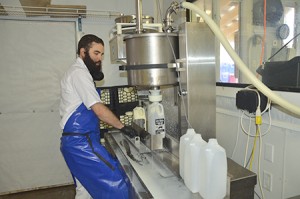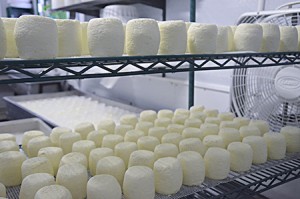

copyright the Chronicle May 6, 2015
by Nathalie Gagnon-Joseph
The six-year-old Farm to Plate initiative appears to be doing its job and has noticeably helped bolster Vermont’s farm and food economy, according to a report released earlier this year.
Among other things, the report, conducted by the Vermont Sustainable Jobs Fund, says that, statewide, there were 748 food manufacturing firms in the state in 2014, a 37 percent increase over 2009. And between 2009 and 2013 4,189 new jobs were created in the food system. In all, about 60,000 Vermonters are employed as farmers, waiters, cheesemakers, brewers, bakers, butchers, grocery stockers, restaurateurs, manufacturers, marketers, distributors and other food related jobs, the report says.
Farm to Plate was part of the Vermont Recovery and Reinvestment Act of 2009.
It was set up to increase economic development in the food and farm sector, create jobs, and improve access to healthy, local food.
Towards that end, a variety of organizations collaborate to help agricultural ventures, as well as connect farmers with markets.
“When food is made locally, and bought or consumed locally, you can have a great impact on the economy,” said Sarah Waring, the executive director of the Center for an Agricultural Economy in Hardwick. “For example, if a cheesemaker uses local milk, you’d have a dairy farmer’s job, as well as a cheesemaker’s job.”
Blair Johnson is Sweet Rowen Farmstead’s creamery manager and head cheesemaker. He spent Friday bottling half-gallons of milk and flipping cheeses in their plastic containers to drain out the whey evenly and shape them.
“We were only bottling 110 bottles per day,” he said about production when he started working at the East Albany business. “Now we’re doing 140 bottles.”
The amount of cheese Sweet Rowen makes has also increased. Before, they made 100 farmers cheeses, and now they make 140 plus 50 soft cheeses, or “bloomies,” Mr. Johnson said.
Sweet Rowen Farmstead milk and cheese is sold in many Orleans County cooperatives and grocery stores. The Farm to Plate initiative contributed to the farmstead’s success, and to the success of other farms like it.
Sweet Rowen started up about four years ago, thanks to the Vermont Farm and Forest Viability Program, which is a member of the Farm to Plate network.
Once farmstead owner Paul Lisai was accepted into the program, he met with a business planner six times in one year who helped him build a business plan.
“This program immediately gave us the professionalism to apply for grants,” Mr. Lisai said. “That’s how we were able to grow really quickly.”
Mr. Lisai started out with eight cows and now he maintains a 40-cow herd.
In his first year he processed 50 gallons of milk per week. Half of that was bottled and sold; the other half became cheese. Now he processes 800 to 1,000 gallons of milk per week in the summer.
“It was definitely a struggle for the first couple years,” he said. “We’ve finally reached a sustainable scale.”
Four years ago he worked alone with a part-time employee. Now he has a business partner, a full-time employee, Mr. Johnson, and welcomes two college students for three-month internships in the summer.
On Mondays and Thursdays Mr. Johnson prepares the milk that will become cheese by adding bacterial culture and rennet, and on Tuesdays and Fridays he handles the cheese, ladling it into containers and flipping it.
He also experiments to come up with new cheeses. Last weekend was the first time Sweet Rowen Farmstead sold cheddar. They sold their new cheese at the five farmer’s markets where Sweet Rowen has a stand this year — Montpelier, Burlington, Jericho, Stowe, and Winooski.
“That’s the most we’ve ever done,” Mr. Johnson said.
Part of Sweet Rowen’s business plan was to be viable after five years and build wholesale accounts up enough to be able to eliminate market stands entirely, Mr. Lisai said.
He has 30 wholesale accounts within a 100-mile radius of Albany, and he continues to work on increasing the number. Mr. Lisai expects to reach his five-year goal on time. The next step is to improve quality of life for himself and his employees, he said.
That means reducing his 13-hour workdays, and increasing Mr. Johnson’s salary so he doesn’t have to work elsewhere.
Now the viability program is helping Mr. Lisai keep up with his own business’ growth.
The program is helping him financially to bring in a grazing specialist to better manage his herd.
The Vermont Farm and Forest Viability Program focuses on helping farms build a business plan, like it did for Sweet Rowen Farmstead.
“We work with about 50 to 60 farm and forest businesses per year,” said Liz Gleason, the program coordinator.
Businesses are paired with advisors who explore finances and make plans for expansion.
People who apply enroll in a two-year process. The first year is intensive. Business owners have regular meetings with the advisor to get the clearest picture possible of their business.

The second year is devoted to follow-up and skill building in areas like financial management, bookkeeping, or legal issues, Ms. Gleason said.
The Northern Community Investment Corporation (NCIC), a member of the Farm to Plate network, helps businesses make connections to improve their productivity.
“We get a lot of requests for marketing,” said Kate Robinson, a project manager for NCIC.
The work includes setting up websites, branding, and label development, among other things. Ms. Robinson’s main focus as a project manager has been on agricultural businesses.
“When institutions like hospitals and schools buy local, it’s supporting local farmers so they can hire local staff, or even keep their doors open at this point,” she said.
Her job is to help local farmers make the necessary connections, and build their capacity to respond to that type of demand.
“The more demand there is from customers, the more hands are needed on the farm,” Ms. Robinson said.
Green Mountain Farm-to-School, another member of the Farm to Plate network, gives local food businesses the opportunity to present their products to a variety of potential buyers through a program called Farm Direct.
“A lot of people want to support local food, but there can be a lot of confusion,” said Livy Bulger, the Farm Direct coordinator. “We’re able to streamline.”
Every week businesses send in a list of their products. Farm Direct then streamlines those lists into a single list to send out to buyers. Buyers pick what they want from the list and receive a single bill for their order, Ms. Bulger said.
“We try to work with smaller scale producers with no access to larger institutions without a middle person,” she said.
Farm Direct also handles pickup and delivery of goods, Ms. Bulger said.
The Northeast Kingdom is home to many successful local agricultural businesses, including Pete’s Greens in Craftsbury.
“We do grow each year,” Pete’s Greens Sales Manager Tim Fishburne said about business.
He estimated that Pete’s Greens employed about 12 people off season and 18 people in season in 2009. Now those numbers have grown to 18 people off season and 24 in season.
“We’re pretty good at marketing and selling our products,” Mr. Fishburne said.
Kathryn A. Olson of the Boston College Department of Sociology made Hardwick the object of a case study in February 2015, entitled “Growing in place: Building a local food economy in Vermont.”
The study reveals how the concentration and diversity of agriculture-based businesses in the area has created jobs. Best of all, many of those jobs are “professional and managerial-level positions that are rare in the area,” the study says.
Ms. Olson used Glover as a comparison to Hardwick, explaining that the two towns have a similar demographic, but Hardwick has more local agricultural activity.
Glover’s statistics, such as unemployment rates — 2.1 percent in 2012, down from 2.7 percent in 2000 — haven’t improved as drastically as Hardwick’s — 2.9 percent unemployment in 2012, down from 4.4 percent in 2000 — yet they show movement in a positive direction.
The Northeast Kingdom as a whole is doing well in the local agriculture department.
According to a 2011 study, the percent change in employment from 2001 to 2009 was an almost 6 percent increase in the agricultural food-processing sector in the Northeast Kingdom, said Alison Low, senior planner at the Northeastern Vermont Development Association (NVDA).

The Northeast Kingdom is also home to a higher share of farms per 1,000 people — 20 — whereas Vermont as a whole has less than 12, and the country has less than seven, according to Ms. Low.
When Farm to Plate was created in 2009, the Northeast Kingdom already had its own NVDA-developed food system action plan and objectives, many of which are mirrored in Farm to Plate goals, including the goal of adding jobs to the market and decrease unemployment.
One of the listed targets is to increase the number of farms by 15 percent by 2017 from 2007 levels.
“Agriculture has long been a foundation for both job creation and community development,” Ms. Waring said. “From barn raisings, to spring planting, farming makes the rhythms of rural community life.”
contact Nathalie Gagnon-Joseph at [email protected]
For more free articles from the Chronicle like this one, see our Editor’s Picks pages. For all the Chronicle’s stories, subscribe:
Print subscription
Annual online subscription
Short-term online subscription







